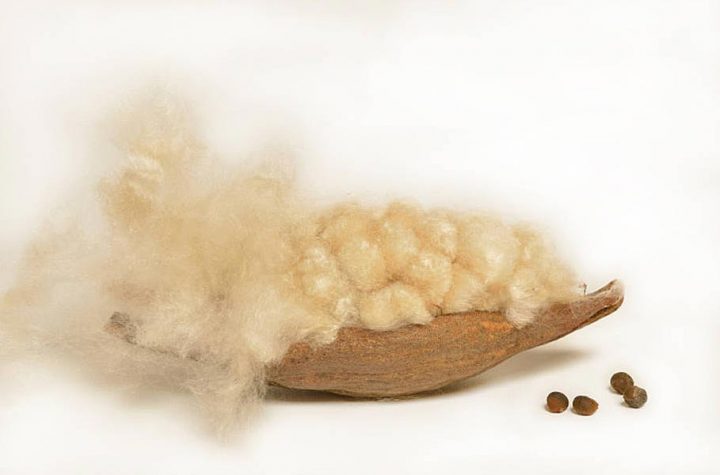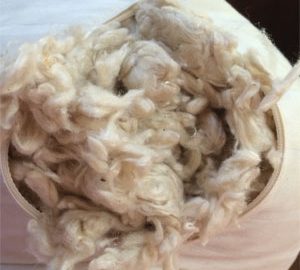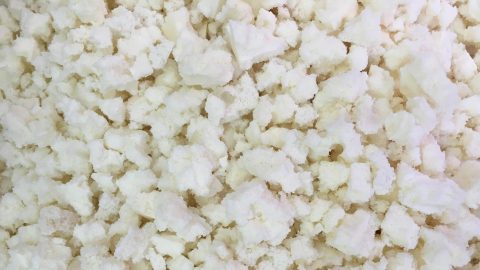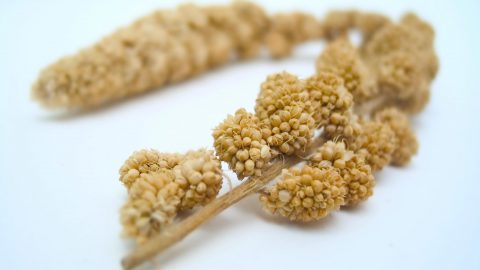
The flower and seeds of the kapok tree
Kapok, or ceiba pentandra, is a tropical tree native to Mexico. Kapok trees thrive in the rainforest grow to be quite impressive. They can be 200 feet tall with trunks as wide as 9 feet.
Kapok is a deciduous tree and drops its leaves following seasonal periods of heavy precipitation. While the tree is leafless, flowers appear. If they’re pollinated (most often by bats!), the flowers will produce a fluffy, cotton-like material containing hundreds of seeds. This light brown, soft fibre is sometimes called silk cotton or kapok cotton.
Kapok’s qualities have made it popular for filling pillows, upholstery, and even life preservers, but its use has dramatically declined since the introduction of synthetic polyester/polyurethane foams.
Kapok filling is currently experiencing a small revival thanks to its all-natural characteristics.
Kapok is an attractive alternative to other fill types like down, feather or synthetic foam because kapok is:
- free of the potentially toxic materials in many foam pillows.
- cruelty-free. The practice of gathering feathers and down for use in pillows is considered by many to be inhumane.
- a compostable and biodegradable resource that reduces waste.
Is kapok hypoallergenic?
Kapok fill is often marketed as being “hypoallergenic.” Unfortunately there is no regulation in the United States that defines or governs the use of the term, so manufacturers of all pillow types use the term quite liberally. Consequently, hypoallergenic claims often don’t carry much water.
It’s unclear how common genuine kapok allergies are because allergic reactions are often incorrectly attributed to kapok when the true cause is dust mites and/or mold. However, one study found that 10 patients out of 59 were allergic to kapok. Other studies show that kapok will accumulate dust mite allergens more quickly than other fibers. Given the evidence, calling kapok hypoallergenic is, at best, an overstatement.
That said, kapok can be an alternative for those allergic to other pillow filling types.

These smokers are about to catch their comfy new kapok pillows on fire. Sleep well!
Careful — kapok is flammable!
Unfortunately kapok is extremely flammable. Its flammability is partially to blame for its decline in popularity. If you’re accident prone and burning incense or anything else near your bed, kapok might not be a great pillow to have around.
While flammability is a viable concern, be aware that many traditional bedding products are treated with really nasty chemicals like formaldehyde to make them fire retardant. Is kapok’s flammability more of a concern than exposure to potentially dangerous chemicals? I would prefer kapok to a lot of the potentially toxic fire-retardant pillows currently available!
I ordered a kapok pillow and gave it a try.
I’d done plenty of reading about kapok, but I never tried sleeping on it. I researched a few different kapok pillows available on the internet and added one of the favorably-reviewed ones to my cart. A few days later, it was time to give kapok a whirl!

My kapok pillow with its zippered opening
When I opened the pillow, I examined the pillow’s filing carefully. It looked quite different from the stock image at the top of this page. The kapok was slightly clumped together in thick, light brown strands and a few small pieces of the seeds were scattered throughout. The clumps tear into smaller pieces easily, but the individual fibers attract and cling to one another giving it an interesting soft texture similar to raw cotton.
A deep inhalation of the kapok thankfully revealed no discernible odor.
It came with instructions: “How to wash your kapok pillow”
Unfortunately kapok stuffing doesn’t hold up too well in a washing machine. Much like wool, it’s prone to clumping and/or mold growth if not cleaned properly. Thus the manufacturer recommended to machine wash only the fabric case.
Intrigued, I slept on my kapok pillow for the first time.
Initially my new pillow was way too thick. The pillow pushed my head upward at an uncomfortable angle. No problem — it included included a zipper on the side, allowing me to remove some of the kapok to give it more appropriate, thinner loft.
As someone who’s accustomed to sleeping on a buckwheat pillow, kapok was an abrupt change for me. The kapok fill has a fairly uniform density and when compressed it tends to spring back into its original shape. Each night I’d squish and mash the pillow’s fill in an effort to mold it into a more comfortable configuration with little success. This soft loaf refused hold its shape.
Kapok is frequently compared to down. Down and kapok are both soft, but I found that the similarities ended there. I’d say that it’s more similar in texture and consistency to cheap polyester fiberfill. Moldability isn’t the only characteristic of a good pillow, so I shrugged it off and left it on my bed. I know from experience that its necessary to give a new pillow up to two weeks to get used to it.
Kapok Pillow Conclusions:
The lack of head and neck support bothered me. Inevitably, in the middle of the night, my pillow would shift and my neck would be elevated either too high or two low. Changing the amount of fill didn’t help. I longed for my faithful buckwheat pillow that perfectly filled the space between my neck.
After only a few days, I noticed that the kapok was starting to develop lumps, much like polyester foam or wool pillows do. For this reason, I imagine it will not last very long. I was surprised to see this happen so quickly because some of the marketing literature suggested that kapok resisted clumping. Regular maintenance with frequent refluffing might help to prevent this from happening.
After a couple of weeks of patient experimentation, I gave up. The kapok pillow ended up in my closet, alongside a growing pile of other pillow types.
Kapok pillows certainly have their advantages.
I think it’s a good choice for those that are looking for an all natural alternative to softer pillow types like down or polyester foam pillows. Not all, but some kapok pillows include a zippered opening, which is a big plus. This makes it easy to add or remove kapok so that you can adjust the loft (height) to your personal preference. You can’t do that with down pillows!
For me, the lack of moldability was the kapok pillow’s biggest flaw.
I just couldn’t make it stay in the shape I wanted and as a result I wasn’t getting the best sleep. Read some of the kapok pillow reviews at Amazon.com and you’ll find that it’s a common complaint. If you’re looking specifically for an all natural alternative to a soft pillow filling like down or polyester, kapok could be a good upgrade for you. It’s safe (as long as you keep it away from fire), doesn’t have any chemical odor and will provide roughly the same sleeping experience.
For most, I think that there are far better options
… like our own Hullo™ buckwheat pillow! Give one a try and I think you’ll agree that it’s superior to other pillow types. Don’t take my word for it — check out these customer reviews.
*Edit 7/13/2018* Two years after writing this, I felt it necessary to update this post. My kapok pillow still doesn’t get much use, but it does come out of the closet for an occasional guest or pillow fort. It has held up better than expected. It has proven itself to be more resistant to clumping than I initially thought.




